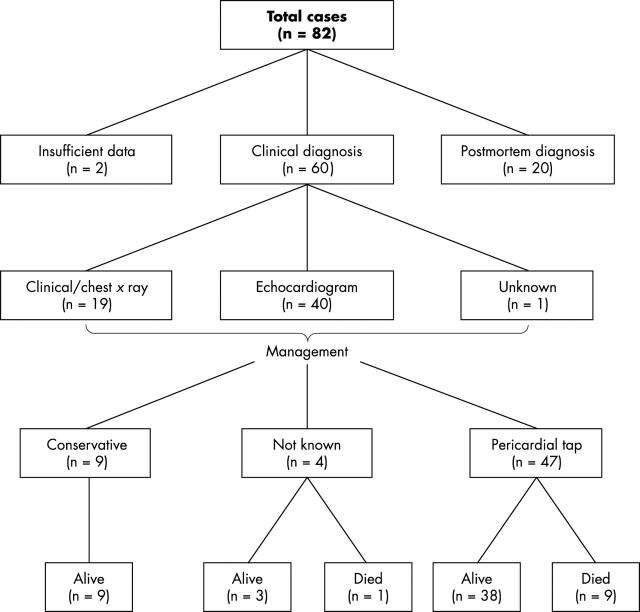Abstract
Aim: To estimate the frequency of pericardial effusion/cardiac tamponade associated with the use of neonatal percutaneous long lines (PLLs) over the past five years.
Method: A retrospective nationwide postal survey, of all neonatal and special care units in the United Kingdom.
Results: Eighty two cases of pericardial effusion/cardiac tamponade were reported from the five year period, during which we estimate that 46 000 PLLs were inserted. The calculated frequency of pericardial effusion/cardiac tamponade occurring with PLLs was 1.8/1000 lines. There were 30 deaths, giving a fatality rate after pericardial effusion of 0.7/1000 lines.
Conclusions: Pericardial effusion/cardiac tamponade is a serious but infrequent complication of PLL use.
Full Text
The Full Text of this article is available as a PDF (119.6 KB).
Figure 1 .
Management and outcome of neonatal pericardial effusion/cardiac tamponade.
Selected References
These references are in PubMed. This may not be the complete list of references from this article.
- Beattie P. G., Kuschel C. A., Harding J. E. Pericardial effusion complicating a percutaneous central venous line in a neonate. Acta Paediatr. 1993 Jan;82(1):105–107. doi: 10.1111/j.1651-2227.1993.tb12532.x. [DOI] [PubMed] [Google Scholar]
- Collier P. E., Goodman G. B. Cardiac tamponade caused by central venous catheter perforation of the heart: a preventable complication. J Am Coll Surg. 1995 Nov;181(5):459–463. [PubMed] [Google Scholar]
- Fischer G. W., Scherz R. G. Neck vein catheters and pericardial tamponade. Pediatrics. 1973 Dec;52(6):868–871. [PubMed] [Google Scholar]
- Goutail-Flaud M. F., Sfez M., Berg A., Laguenie G., Couturier C., Barbotin-Larrieu F., Saint-Maurice C. Central venous catheter-related complications in newborns and infants: a 587-case survey. J Pediatr Surg. 1991 Jun;26(6):645–650. doi: 10.1016/0022-3468(91)90001-a. [DOI] [PubMed] [Google Scholar]
- Harms K., Herting E., Krüger T., Compagnone D., Speer C. P. Perkutane Silastic-Katheter bei Neu- und Frühgeborenen. Ein Erfahrungsbericht über 497 Katheter in 5 Jahren. Monatsschr Kinderheilkd. 1992 Aug;140(8):464–471. [PubMed] [Google Scholar]
- Khilnani P., Toce S., Reddy R. Mechanical complications from very small percutaneous central venous Silastic catheters. Crit Care Med. 1990 Dec;18(12):1477–1478. doi: 10.1097/00003246-199012000-00030. [DOI] [PubMed] [Google Scholar]
- Leipälä J. A., Petäjä J., Fellman V. Perforation complications of percutaneous central venous catheters in very low birthweight infants. J Paediatr Child Health. 2001 Apr;37(2):168–171. doi: 10.1046/j.1440-1754.2001.00625.x. [DOI] [PubMed] [Google Scholar]
- Parry G. J., Gould C. R., McCabe C. J., Tarnow-Mordi W. O. Annual league tables of mortality in neonatal intensive care units: longitudinal study. International Neonatal Network and the Scottish Neonatal Consultants and Nurses Collaborative Study Group. BMJ. 1998 Jun 27;316(7149):1931–1935. doi: 10.1136/bmj.316.7149.1931. [DOI] [PMC free article] [PubMed] [Google Scholar]
- Reece A., Ubhi T., Craig A. R., Newell S. J. Positioning long lines: contrast versus plain radiography. Arch Dis Child Fetal Neonatal Ed. 2001 Mar;84(2):F129–F130. doi: 10.1136/fn.84.2.F129. [DOI] [PMC free article] [PubMed] [Google Scholar]
- Sullivan C. A., Konefal S. H., Jr Cardiac tamponade in a newborn: a complication of hyperalimentation. JPEN J Parenter Enteral Nutr. 1987 May-Jun;11(3):319–321. doi: 10.1177/0148607187011003319. [DOI] [PubMed] [Google Scholar]
- Wirrell E. C., Pelausa E. O., Allen A. C., Stinson D. A., Hanna B. D. Massive pericardial effusion as a cause for sudden deterioration of a very low birthweight infant. Am J Perinatol. 1993 Nov;10(6):419–423. doi: 10.1055/s-2007-994621. [DOI] [PubMed] [Google Scholar]



